Two of my recent blog posts have been about the need for combustion air ducts and common problems with combustion air ducts, but I never covered the topic of connecting a combustion air duct directly to the plenum on a furnace. This actually used to be standard practice for a long time; the crude diagram below shows how this worked.
When the combustion air duct is connected directly to the return plenum for a furnace, the blower fan on the furnace pulls outdoor air in to the return plenum. To supply this air to the furnace room, a supply register is added at the ductwork in the same room, typically right above the furnace. This is an undesirable setup, for a number of reasons.
Waste of Energy
During the winter, this setup pulls cold outdoor air in to the house, directly in to the return plenum for the furnace. While a combustion air duct that terminates at the floor will allow cold air to come in to the house, it’s not nearly as much air compared to the duct connected to the furnace return plenum. When it’s very cold outside outside, that’s a ridiculous amount of cold air being pumped in to the house, but because it gets tempered by the furnace, nobody feels it. This is a big waste of energy.
During the summer, the opposite happens. This setup pulls warm, moist outdoor air in to the house just before the air conditioner’s evaporator coil, as shown below. Again, this is a waste of energy.
Pressurizes the House
When a combustion air duct is connected directly to the return plenum on a furnace, the house becomes pressurized when the furnace blower fan starts running. How does this air leave the house? Any way it can; plenty of these household air leaks were covered in this post about why houses need combustion air ducts.
The air leaks that really cause problems are the air leaks found in the attic. Attic air leaks lead to frost in the attic as well as ice dams, and the effect is magnified when a combustion air duct is connected to a furnace return plenum.
Code Violation
As a home inspector I don’t get hung up on code requirements, but as long as I’m blogging about this topic, it’s worth mentioning that the Minnesota State Mechanical Code no longer allows the combustion air duct to be connected to the return plenum. Section 708.1, #3 says:
[Combustion air ducts shall:] Terminate in an unobstructed space allowing free movement of combustion air to the appliances.
Frequently Disabled
While it’s common for home inspectors to find combustion air ducts stuffed shut with clothing inside the house, it’s actually even more common for the combustion air duct to be disabled when it’s connected to the return plenum.
Remember, that register above the furnace is what supplies combustion air to the furnace room. Because this register is located right above the furnace, it’s also the most powerful register in the house, which makes the furnace room very warm during the winter. When well-intentioned homeowners don’t understand how their combustion air is connected, they assume that the register above the furnace is only there to supply heat to the room, so they block it off to get more heat to the areas that matter. This prevents combustion air from getting to the appliances that need it.
Note the cardboard blocking this opening in the photo below, despite the stern warning from the HVAC contractor.
What To Do
If the connection from the combustion air duct to the return plenum is visible inside the house, the fix for this situation is simple: have the combustion air duct disconnected from the furnace return plenum, and have the duct dropped down in to the room. Also, have the old hole in the return plenum blocked off.
Any HVAC contractor should be able to help make this simple change, which is something we’ve recommended to countless home inspection clients.
Related Posts:
- Combustion Air Ducts, Part I: Why Houses Need Them
- Combustion Air Ducts, Part II: Problems and Solutions
Author: Reuben Saltzman, Structure Tech Home Inspections

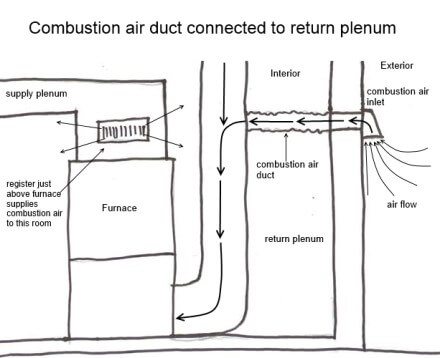
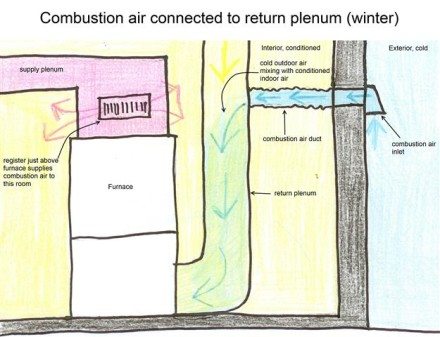
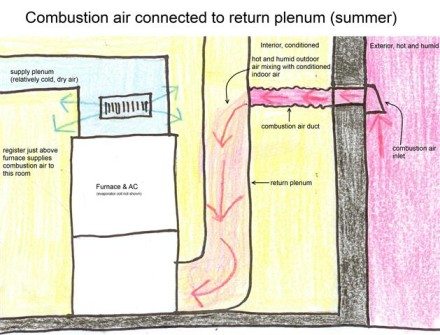
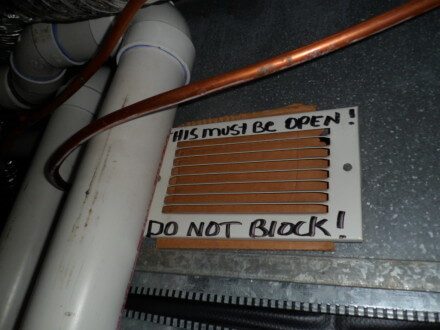
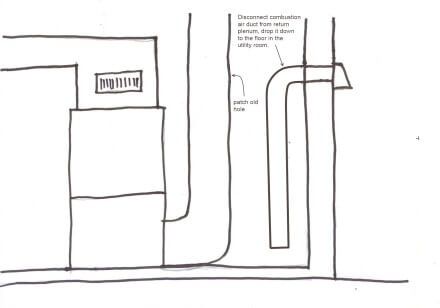
Chris Halloran
April 9, 2013, 8:52 am
Great writeup, Reuben – thank you!
I’m not the sharpest knife in the drawer, so I hoping you can further clarify something in this post…
In the “Frequently Disabled” section, you mention that combustion air ducts are frequently closed/disabled by homeowners… My combustion air duct is not connected to the plenum, and is indeed properly set up near my furnace (setup in accordance with your 2 previous blog posts).
With that in mind, is it then OK to close off or tape over the register above my furnace (since it’s not serving as the “combustion air duct”)?
Thanks again!
Reuben Saltzman
April 9, 2013, 11:12 am
Hi Chris,
Yes, if the combustion air duct is not connected to the return plenum on the furnace, it’s ok to block off that air supply in the furnace room.
Andy
April 10, 2013, 1:33 pm
My guess is anyone that connected the “Combustion Air” Duct to the furnace was trying to create a cheap dual use combustion/fresh air delivery system for the home. With the absence of an air exchanger (HRV) this set up is a way to introduce fresh air inexpensively. Their are a lot better ways to provide fresh air to a home than connecting a duct to the return; unfortunately none of those ways are cheaper.
The positives that comes with ventilating a home are many (think home as a fish tank and ventilation as the aerator). Ventilation will cost money because you are introducing fresh air into the home and that will require additional energy; however using an HRV will minimize energy usage because you are able to recover the energy from the exhaust air and temper the fresh air coming in with that same energy.
gwhavens
November 5, 2013, 5:05 pm
wait … I heard an instructor in a home inspection class say that a supply vent within 10′ of the furnace was a danger that could cause “double burns”. What the heck is a double burn? I assumed at the time that this meant that a furnace leaking CO would then have the CO burned again as it was sucked into the furnace … or something … something.
… and how does that vent near the furnace supply fresh air? Where in a well-sealed duct system does fresh air enter?
Reuben Saltzman
November 6, 2013, 4:52 am
@gwhavens – the instructor was probably talking about openings in the return air. The concern would be that exhaust gases could get pulled into the return air stream.
I’ve never heard the term “double burn”.
As for supplying combustion air to the room, the air comes into the return duct from the outside, goes through the filter, the blower fan, the heat exchanger, the AC evap coil, then comes out a register in the supply ductwork.
Frost in Attics | Structure Tech Home Inspections
December 17, 2013, 4:44 am
[…] a home has a combustion air duct connected to the return plenum, the house gets pressurized when the furnace runs, which increases the effects of attic air leaks. […]